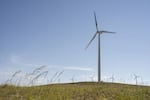
A wind turbine with one of its blades painted black stands across a grassy field near Glenrock, Wyo. Researchers hope the black blade will help birds see it better and avoid injury or death.
Courtesy of Oregon State University
Hundreds of thousands of birds and bats die each year from hitting wind turbines. Now Oregon State University researchers are looking to reduce those collisions with a simple paint scheme.
The research builds on a study done in Norway that found bird collisions with turbines dropped 72% by painting one turbine blade black.
Christian Hagen, a senior researcher with OSU’s Department of Fisheries, Wildlife, and Conservation Sciences, explained the concept behind it to KLCC.
“If you imagine your bike wheel spinning down the road going really fast, you really can’t see the spokes anymore. And so the same kind of principle applies to a turbine blade,” said Hagen. “Those things are ripping around a couple of miles an hour, and they just kind of become invisible on the landscape. So by painting one of those blades black, it actually interferes this invisible blur.”
This summer, roughly 30 wind turbine blades have been painted black at a Wyoming wind farm operated by project partner PacifiCorp. Hagen said dog teams will check the site for bird and bat carcasses as part of their survey efforts.
In its release, OSU says many of the birds adversely affected by turbines are protected by federal laws such as the Migratory Bird Treaty Act and the Bald and Golden Eagle Protection Act.
“The Bald Eagle was on the endangered species list not too very long ago,” said Hagen. “And they’ve been pulled off the endangered species list. And it’s not that wind provides that much of a threat, but you certainly don’t want to be providing 1,000 cuts that brings the species to the brink of that status again.”
Related: Washington bill would restrict blinking nighttime lights on wind turbines
The study aims to determine the effect of painted blades on reducing fatality rates among eagles, other birds, and bats. The hypothesis is that eagles and other birds active during the day will be able to detect the painted blades, whereas bats, which rely more on auditory cues and have different visual capabilities, may not perceive the painted blades as effectively.
Hagen and a doctoral student in his lab, Natia Javakhishvili, are working together on the project. One model being developed integrates recorded bird movement data from the research site to assess whether painted turbines result in increased bird avoidance.
As Javakhishvili’s primary focus will be on golden eagles, she’ll use an extensive pre-existing dataset containing 8 million points of golden eagle movements to enhance the model’s accuracy.
“This study is particularly rigorous and comprehensive due to its incorporation of altitude as a third dimension in the analysis, capturing vertical flight dynamics often overlooked in traditional studies,” Javakhishvili stated in OSU’s release. “This detailed analysis helps us understand how eagles navigate around turbines and other infrastructure like roads and power lines, which, in turn, helps us develop better strategies to protect them.”
The researchers are also monitoring similar studies being conducted in Spain, Sweden and South Africa.